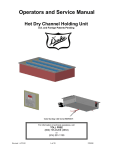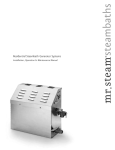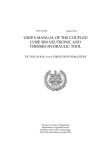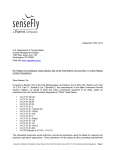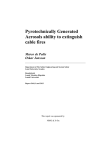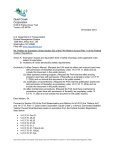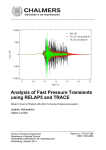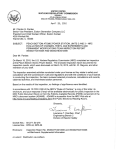Download Jacobsen Engineering Ltd. - Office for Nuclear Regulation
Transcript
Jacobsen Engineering Ltd. www.jacobsenengineering.com 15 April 2011 Response to the Office of Nuclear Regulation’s “Invitation to submit information on the implications of the Fukushima nuclear accident” By Jacobsen Engineering Ltd Introduction The purpose of this paper is to provide information identified by Jacobsen Engineering Ltd on the Fukushima accident, and to comment on a set of relevant issues arising. As background, Jacobsen Engineering Ltd is currently a Technical Support Contractor to HSE Nuclear Directorate in the area of Probabilistic Risk Assessment (PRA), having assisted on various PRA reviews, including support to the review of submissions for Generic Design Assessment. Our expertise includes Level 1 (core damage frequency assessment), Level 2 PRA (radiological release frequency assessment), Level 3 PRA (consequence assessment) and severe accident analysis . As a company we are active internationally as well as nationally. All this background informs our perspective and knowledge of issues related to the Fukushima accidents. This paper has the following content: 1. Summary of basic information obtained on the Fukushima I units design. 2. Summary of key events of the Fukushima accidents. 3. Generic information on Station Blackout1 accidents in BWRs with Mark I containment and identification of useful supporting references. 4. Identification of open questions about the accidents. 5. Relevant insights from Probabilistic Risk Assessments. 6. Lessons learnt and issues arising from the Fukushima accident. 1 A “Station Blackout” is a condition where there is a total loss of all high voltage AC power, including loss of backup diesel generator units. Jacobsen Engineering Ltd. www.jacobsenengineering.com Fukushima Plant Design Units 1, 2 and 3 of the Fukushima I site are BWRs with Mark I containments. These units differ somewhat in reactor coolant system and safety system design. [Fujimoto et al, 2009] provides information about the Fukushima I units. Unit 1 is a BWR-2/3 (460 Mwe). Units 2 and 3 are BWR4 (784MWe). Based on Tables 3-1 and 3-2 of [Lin, C. C., and Lehner, J. R., 1991], which list similar units located in USA, net electric output power is approximately 32% of core thermal power. The core thermal power of the Fukushima I units can therefore be estimated from the net electric power. The BWR-2/3/4 units are equipped with numerous injection systems to maintain adequate core cooling following a reactor trip. Several of these systems require high voltage AC electric power. There are three systems which do not require high voltage AC electric power, these being High Pressure Core Injection (HPCI), Reactor Core Isolation Cooling (RCIC) and the Isolation Condenser (IC). These systems are briefly described below. HPCI and RCIC are two independent systems used to provide water injection into the isolated reactor vessel at high pressure. Both require only DC electrical power for operation and use steam turbine driven pumps. The steam is taken from the main steam piping upstream of the Main Steam Isolation Valves (MSIVs) and the turbine exhaust steam is discharged into the pressure suppression pool. Both systems are normally aligned for the pumping of water from the condensate storage tank into the reactor vessel via a connection into a feed water line. The systems are automatically initiated on low vessel water level. The turbines in both systems will trip on high vessel water level. Both systems will isolate (their steam supply valves will shut) if the RPV pressure becomes too low to permit turbine operation. The systems will also isolate if the ambient temperature in the vicinity of their turbines reaches 93.3 deg C. [IAEA,2009] provides a description of the Isolation condenser, which is repeated below: "In addition to the ECCS network, the BWR/2 design includes isolation condensers to provide decay heat removal from the vessel in the event that the main steamline isolation valves are closed and the main condenser is unavailable as a heat sink. The isolation condensers are simply passive heat exchangers located in pools of water above the vessel and outside the containment. Steam from the reactor vessel is passed through the heat exchanger tubes, condensed, and the condensate is returned to the vessel. The water on the shell side of the heat exchange is boiled and vented to the atmosphere.". Thus, the Isolation Condenser is a passive heat removal system which does not depend on the battery power for long term operation, although its operability is limited by the water available in the Isolation Condenser tank. It will eventually lose heat removal capability as the pools heat up2. 2 We have not been able to check if the pools are connected to the plant ultimate heat sink, but this would not be available in the case of a Station Blackout sequence such as that which occurred at Fukushima, therefore continuous heating of the pools would be anticipated in the sequences discussed here. Jacobsen Engineering Ltd. www.jacobsenengineering.com According to [Fujimoto et al, 2009], the Isolation Condenser is only present on Fukushima I Unit 1. Unit 1 is also equipped with HPCI. Units 2 and 3 have RCIC and HPCI. The Mark I BWR containment consists of a “light bulb” shaped primary containment “drywell”, surrounded by a secondary containment building. The drywell is connected to a donut shaped torus which contains water (the suppression pool). The water in the torus is connected to the plants heat removal systems, and thus provides the heat removal path from the containment following reactor trip and isolation of the main steam lines. Figures can be found in [USNRC, date unknown]. The Fukushima I Accident Sequence The Fukushima accident sequence was a Station Blackout sequence initiated by a seismic event with consequent Tsunami. Some key events of the accident sequence at Unit 1 are presented in Table 1 (next page). The principle difference between the Unit 1 accident and the accidents at Units 2 and 3 appears to be the provision and availability of injection systems at Units 2 and 3. As discussed above, Units 2 and 3 are equipped with both RCIC and HPCI. Many details of the Units 2 and 3 accidents are unclear to us but it does appear that both these systems were available. [Cook, D. H., et al, 1981] discusses the use of RCIC and HPCI in Station Blackout accidents, and identifies a number of limitations on the operability of these systems, including: (1) availability of DC power (battery life), (2) suppression pool temperature, when suction is taken from the suppression pool (a number of effects are discussed). In conclusion, it is expected that HPCI and RCIC would eventually fail in a Station Blackout scenario. It will be useful to establish how long the systems operated for and any actions taken by the operators to extend availability (e.g. use of alternate batteries, or intermittent operation of HPCI versus RCIC to mitigate local temperature rises near to the turbines – see section 8.1 of [Cook, D. H., et al, 1981]). We have been able to find very little detailed information about the accident in the Spent Fuel Pool (SFP) of Unit 4. Normally the temperature of the SFPs would be maintained at 25°C. Following total loss of AC power, it is expected that the cooling function would be lost, i.e., after failure of the emergency diesel generators at 06:41 GMT on 11.03.2011.It is expected that the temperatures in the spent fuel pool would slowly rise from this time on, however, we have not been able to find details of the development of the SFP temperatures in the sources we have reviewed. Jacobsen Engineering Ltd. www.jacobsenengineering.com Table 1: Key Event Timeline for the Accident at Fukushima I Unit 1 Date and Time Event 11.03.2011 5:46 GMT Seismically induced Loss of Offsite Power (LOOP). The Emergency Diesel Generators started normally and supplied power for the heat removal systems. According to the official reports by TEPCO [TEPCO, 2011] and NISA [NISA, 2011] there was no significant damage to the plant equipment. (T0) 11.03.2011 6:41 GMT (T0+55 min.) Emergency Diesel Generators failed to run as a direct consequence of the tsunami impact triggered by the earthquake [TEPCO, 2011]. Being higher than design predictions the tsunami caused flooding that failed all emergency AC power systems. At that time the Isolation Condenser has been used for cooling the core [TEPCO, 2011]. At the time the diesel generators were lost, initating the Station Blackout condition, the capacity to remove heat from the suppression pool would also be lost, as the suppression pool cooling circuit depends on electrically powered pumps. Thus, although it was possible to inject water to the reactor core, the reactor and containment system would, from this point on be continuously heating up. If water from the condensate storage tank was used the reactor core temperature and water level would be expected to be stable, but the containment temperature and pressure would still be expected to rise, requiring eventual venting. 11.03.2011 07:36 GMT Unit 1 core cooling function was lost [TEPCO, 2011]. The reason for Isolation Condenser failure has not been reported. After failure of the Isolation Condenser, Unit 1 would have no active cooling mechanism available. (T0+1h 50 min.) We have not been able to find in the reports made by TEPCO and IAEA any specific information about any attempts made by the operators to depressurise the RPV at Unit 1. 12.03.2011 01:17 GMT Around 17h 40 min after the loss of core cooling the plant operators started relieving the pressure in the suppression pool of Unit 1 by venting the steam to the atmosphere. [NISA, 2011] (T0+ 19h 31 min.) We have not been able to identify any reports clarifying how the venting was carried out: e.g., one or two venting operations, or what systems were used for venting. 12.03.2011 6:36 GMT The first hydrogen explosion occurred at Unit 1 as reported by TEPCO and IAEA. (T0+23h 52 min.) 12.03. 2011 11:20 GMT Accident mitigation started by spraying sea water to the RPV at Unit 1 using fire pumps, according to [TEPCO,2011] and [IAEA,2011]. (T0+27h 44 min.) The reported time of seawater injection implies that the reactor core may have been without cooling or injection for around 26 hours. Jacobsen Engineering Ltd. www.jacobsenengineering.com The Generic Station Blackout Sequence for BWRs with Mark I Containment In the case of Fukushima the ultimate cause of the Station Blackout (SBO) was the seismic event (which generated the subsequent Tsunami). SBO sequences at BWR reactors with Mark I containments have been analysed in considerable detail many times during the past 30 years. See for example [Cook, D. H., et al, 1981] and [Madni, 1994].. The analysis of [Cook, D. H., et al, 1981] is for Browns Ferry NPP in the USA and the analysis of [Madni, 1994] is for Peach Bottom (USA). These reactors are somewhat larger than Fukushima I Units 1,2, 3. According to Table 3-1 of [Lin, C. C., and Lehner, J. R., 1991], Browns Ferry Unit 1 is 1065 MWe (Peach Bottom: 1069MWe). The Fukushima units are also likely to have smaller core volumes and smaller containment volumes, which to some extent would offset the lower power but not entirely. Based on Tables 3-1 and 3-2 of [Lin, C. C., and Lehner, J. R., 1991], the power of Fukushima I Unit 1 is 43% of that of Browns Ferry Unit 1. However, the suppression pool mass is around 51% of that of Browns Ferry Unit 1 and the containment volume (based on the range of volumes shown in [Lin, C. C., and Lehner, J. R., 1991]) is likely to be 80% of that of Browns Ferry Unit 1. So the containment thermal inertia appears to be 25% to 80% larger relative to core power for Fukushima, compared to Browns Ferry. This would imply slower accident progressions. For Browns Ferry, based on Table 9-3 of [Cook, D. H., et al, 1981] core melting is predicted around 2.6 hours after loss of injection (due to battery failure) and vessel failure is predicted 5 hours after loss of injection. For Peach Bottom, Table 5.1 of [Madni, 1994] shows core melting starting around 2 hours after core uncovery, with vessel failure occurring 4.6 hours after core uncovery. These times are fairly consistent with the Browns Ferry results, and it is noted that [Madni, 1994] presents timings relative to core uncovery, not loss of injection (core uncovery would lag the loss of injection time). We are unaware of any reliable information on the degree of damage in of the cores at Fukushima I, but a general comparison of the timings of the reference analyses mentioned here indicates that this could well be substantial. The timescale for full core degradation after loss of injection is around 2 to 5 hours in both the Browns Ferry analysis and the Peach Bottom analysis; even allowing for differences in scale and thermal power compared to the Fukushima units, these times are very short compared to the apparent 26 hour period without core cooling in Fukushima I Unit 1 (see Table 1). Similarly, some indications of the timing of primary containment pressurisation can be obtained from the [Madni, 1994] analyses. These indicate that drywell overpressure (Table 5-1) would be expected around 7 hours after core uncovery; if core uncovery is based on a battery life of six hours in [Madni, 1994], this implies approximately 13 hours from initiation of the SBO condition. Given the lower power of the Fukushima units, as discussed above, it can be seen that this timescale (~13 hours) is broadly consistent with the reports of venting at Fukushima I Unit 1 approximately 18 hours after loss of cooling (per Table 1). Jacobsen Engineering Ltd. www.jacobsenengineering.com Open questions There are numerous open questions about the accident progression and it was noted in compiling this paper that different sources often appear to have some inconsistencies. Key questions are: • • • • • • • Clarification of the timing of failure/loss of HPCI and isolation condenser on Unit 1 Timing of failure/loss of HPCI and RCIC on Units 2 and 3 Timings and number of venting operations on all units What system was used for venting? [Fujimoto et al, 2009] indicates that the Fukushima units had fitted hard pipe vents. These vents discharge to the stack and therefore their use would be expected to reduce the risk of hydrogen explosion – however hydrogen explosion occurred at Fukushima. If the hardened vent was not used, was this because of problems due to loss of electric power for example? Was cooling restored to the suppression pool at any time? How long did injection systems take suction from the condensate storage tank? (According to [Cook, D. H., et al, 1981] the water in the condensate storage tank may last for more than 8 hours) Was the RPV depressurised on unit 2? Timing of RPV depressurisation on Units 1 and 3. Relevant Insights from Probabilistic Risk Assessments Probabilistic Risk Assessment for Seismic Events and other External Hazards PRA studies carried out for BWRs in Taiwan in 1986, similar to these at Fukushima, identified seismic events leading to loss of offsite power and station blackout as the dominant contributor to risk, [Evans M, 1986/1], [Evans M 1986/2]. As a result of the PRA the two onsite sources of electricity, Gas Turbine, and emergency Diesel Generators, were upgraded to ensure continuity of power, not only following seismic events but also Hurricane and strong winds. This was achieved by ensuring that the onsite Gas Turbine supply cables were underground and thus not affected by switchyard failures. In the case of seismic events, loss of offsite power arises because the fragility of the ceramic insulators in the switchyard is lower than any of the components associated with the safety systems in the plant itself. In the case of flooding the offsite power will be lost either as the result of flooding in the switchyard or the wider grid, and in the strong winds the wider grid outside the plant will be damaged. In all these cases the grid will be unavailable for an extended period of time so particular attention has to be paid to alternate sources of power to maintain long term cooling. In areas of low seismicity, seismically induced loss of offsite power may still be a risk contributor if the design basis earthquake is relatively low. In this case, the situation may be exacerbated by the failure of the grid occurring at a similar Peak Ground Acceleration to the safety related equipment, leading in effect to a “cliff edge” effect just beyond the design basis earthquake. Jacobsen Engineering Ltd. www.jacobsenengineering.com Another example of an external hazard is extremely low temperatures leading to icing of cables and grid failure. This is experienced by stations sighted in areas with cold winters prevalent to ice storms. In this case underground power supplies form an alternative source located some miles from the plant are often in place (e.g., Ringhals NPP, Sweden). While the above examples may not necessarily turn out to be important in the UK (it is important to note that importance cannot be determined a priori) they all point out the necessity of ensuring that detailed, good quality, PRAs are carried out for external hazards which may challenge the power supplies for post trip cooling. Other insights from Probabilistic Risk Assessments More generally, the relative risk of Station Blackout accidents in terms of their contribution to core damage risk for BWRs with Mark I containments is a well known prediction of PRAs. For example, according to [Madni, 1994], the NUREG-1150 study for the Peach Bottom BWR identified Station Blackout sequences as contributing 50% of the risk of core damage. Lessons learnt and issues arising This section lists items which may be considered in the areas of lessons learnt and issues arising. Risk Based Stress Tests The examples given above suggest that the available Probabilistic Risk Assessments contain substantial information about potential challenges to the safety of operating NPPs. In our view, this information should be utilized to the maximum extent. As a process of “stress testing” operating is envisaged, we would therefore suggest including Risk Based Stress Tests. This may be carried out in two ways: 1. Using scenarios extracted from a range of existing PRAs. It is suggested this be done on a generic basis, i.e., the stress tests should not be limited to events identified by a plant's own PRA. 2. Using the PRAs as part of the evaluation of the robustness of the NPP's defenses for the selected stress tests, i.e., carry out PRA based conditional consequence probability assessments. Risk Based Stress Tests should include a range of common cause initiators. A Station Blackout is a risk significant sequence because it is an event with the capability to disable multiple safety systems, i.e., it has common cause impacts. It will be important to ensure that the stress tests include other potential events with common cause impacts. Jacobsen Engineering Ltd. www.jacobsenengineering.com Emergency preparedness In our view, the events at Fukushima I also point to the importance of being well prepared to mitigate potential accidents at NPPs. Elements of being well prepared include: Ensuring the quality of Emergency Operating Procedures to prevent core melting. Ensuring the availability and quality of Severe Accident Management Guidelines to mitigate the consequences of core melting, however unlikely, and to protect the public. Ensuring operator training in all the above. Ensuring that strategies are in place to ensure the availability of supplies needed to implement accident management procedures and guidelines. Ensuring that good quality analysis is available to support the above. As indicated earlier in this paper, full knowledge of operator actions carried out at the Fukushima Units will be useful. Clearly it remains to be seen, but there are indications that, given the difficult situation, much of the accident management may have been handled well (for example, the surprisingly long time that injection appears to have been maintained at Units 2 and 3). Emergency Planning Zones Some attention has been drawn to the question of Emergency Planning Zones in the press, and we therefore offer some comment. The “Radiation (Emergency Preparedness and Public Information) Regulations 2001, (REPPIR)”, and “A Guide to The Radiation (Emergency Preparedness and Public Information) Regulations 2002, HSE, ISBN 0 7176 2240 1” identify the strategies for determining the emergency planning zone. Implementation of Management Guidelines in place require an understanding of the frequency and consequences of the full range of potential severe accidents. If a review of Emergency Planning Zones is carried out, we would suggest considering use of accident sequences derived from Level 2 PSAs. At this time, we have not included relevant references for how this would be done, but are able to identify these as a suitable methodology has been piloted. The use of sequences identified from the Level 2 PRAs would provide a range of potential source terms and associated frequencies of occurrence. This is considered preferable to the use of a single arbitrary “design basis” accident, which does not provide assurance that sufficient weight has been given to potentially more severe, albeit less likely, accidents. Considering such scenarios might impact the choice of EPZ boundaries. Jacobsen Engineering Ltd. www.jacobsenengineering.com References Cook, D. H., et al, 1981. “Station Blackout Sequence at Browns Ferry Unit One – Accident Sequence Analysis”. Oak Ridge National Laboratory. NUREG/CR-2182. November 1981. Evans, M., 1986/1. “The Treatment of Seismically-Induced Loss of Offsite Power Events in Probabilistic Risk Assessment”. ANS/ENS Topical Meeting on Thermal Reactor Safety, San Diego, Cal.ifornia. February 1986. Evans, M., 1986/2. “Determination of Core Melt Frequency Arising from Earthquakes for Nuclear Power Plants Sited in High Seismicity Areas”. ENC-4, Geneva, Switzerland. June 1986. Fujimoto et al, 2009. “Circumstances and Present Situation of Accident Management Implementation in Japan ”. OECD/NEA Workshop on Implementation of Severe Accident Management Measures (ISAMM-2009) . Böttstein, Switzerland October 26 - 28, 2009 . Paper and presentation available at ADD WEB ADDRESS. IAEA, 2009. “Boiling Water Reactor Simulator with Passive Safety Systems - User Manual”. October 2009. IAEA, 2011. “Fukushima Nuclear Accident Update Log”. http://iaea.org/newscenter/news/2011/fukushimafull.html. Lin, C. C., and Lehner, J. R., 1991. “Identification and Assessment of Containment and Release Management Strategies for a BWR Mark I Containment”. Brookhaven National Laboratory. NUREG/CR-5634. September 1991. Madni, 1994. “Analysis of Long Term Station Blackout without Automatic Depressurization at Peach Bottom using MELCOR (Version 1.8)”. Brookhaven National Laboratory, BNL-NUREG52319, NUREG/CR-5850. May 1994. NISA, 2011. Press Releases web site, http://www.nisa.meti.go.jp/english/press/index.html TEPCO, 2011. Press Releases web site, http://www.tepco.co.jp/en/press/corp-com/release/indexe.html USNRC, date unknown. “Reactor concepts manual: Boiling Water Reactor Systems”.















